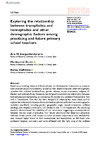Exploring the relationship between transphobia and homophobia and other demographic factors among practicing and future primary school teachers

Use este enlace para citar
http://hdl.handle.net/2183/35434
A non ser que se indique outra cousa, a licenza do ítem descríbese como Atribución-NoComercial-SinDerivadas 3.0 España
Coleccións
- GI-ECIGAL - Artigos [28]
Metadatos
Mostrar o rexistro completo do ítemTítulo
Exploring the relationship between transphobia and homophobia and other demographic factors among practicing and future primary school teachersData
2023-03-18Cita bibliográfica
Amigo-Ventureira, A. M., Durán, M., & DePalma, R. (2023). Exploring the relationship between transphobia and homophobia and other demographic factors among practicing and future primary school teachers. Research in Education, 0(0). https://doi.org/10.1177/00345237231163048
Resumo
[Abstract] Based on an existing measure of homophobia, we developed an instrument to measure both transphobia and homophobia, as well as their relationship with other demographic variables that included attributed sex, gender identity, sexual orientation, religious affiliation, and political affinity. Research was designed to establish the relationship between homophobia and transphobia, by comparing the results of a validated Homophobia Test with a Transphobia Test that has been designed by adapting the same items; and to explore the relationship between homophobia/transphobia and other socio-demographic variables, specifically including gender, geographic origin, sexual orientation, political ideology, and religious conviction). Our research with 1,133 trainee and 182 practicing teachers demonstrated the reliability of our instrument, suggesting a correspondence between the two types of prejudice. Our results also found that these two prejudices followed similar trends with respect to other variables: respondents who identified as men showed higher levels of both homophobia and transphobia, as did those who professed religious conviction and were affiliated with the right wing of the political spectrum. We found that people who identified as gay, lesbian, or bisexual were less homophobic and transphobic that those who identified as heterosexual. Based on these data, we hypothesize that the two types of prejudice explored here derive from a common factor, the broader social construct of cisgenderism, so that any deviation from the heterosexual matrix, whether in terms of gender identity, gender presentation, or sexual orientation, results in social stigma. The professionals included in our sample are entrusted with well-being of all children, and are responsible for teaching about human diversity as part of the curriculum. Our findings will help us understand how teachers might respond to children who transgress, or are perceived to transgress, cisgendered norms, and to design more effective teacher training concerning sex and gender diversity.
Palabras chave
Queer-feminism
Sexuality
Teacher education
Teaching
Marginalisation
Sexuality
Teacher education
Teaching
Marginalisation
Versión do editor
Dereitos
Atribución-NoComercial-SinDerivadas 3.0 España © The Author(s) 2023 Under Sage's Green Open Access policy, the Accepted Version of the article may be posted in the author's institutional repository and reuse is restricted to non-commercial and no derivative uses
ISSN
2050-4608






